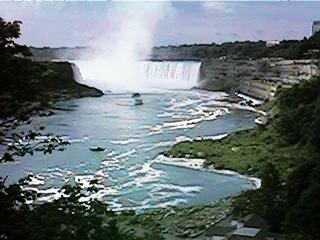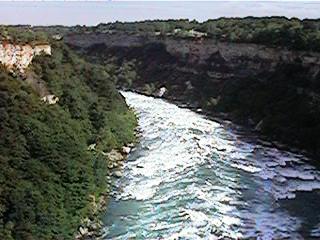 |
 |
 |
 |
The Niagara River is one of the principal sources of hydro electric power in North America. Forming the international boundary between the United States and Canada, it has been a source of water power since the late eighteenth century.
Now the exploitation of this resource is the subject of an international treaty, dating from 1950, which safeguards the interests of both tourism and manufacturing industries. More power is generated at night, with three quarters of the water flow being diverted from the falls to a series of power turbines. During the day a minimum flow of 100,000 cubic feet per second is maintained to safeguard the tourist spectacle.

The initial development of hydro-electric power (HEP) took place during a
period of intense contestation between the relevant merits of direct current
and alternating current. Eddison supported the construction of a direct current
station in 1895, based on his existing designs, but Tesla, a former employee,
had demonstrated the superior transmission characteristics of alternating
current in conjunction with Westinghouse. A second improved station which
opened in 1903 and operated until largelydestroyed by a lanslide in 1956. The
first station was able to supply power to Buffalo, just 20 miles away, but the
AC system secured the paradigm shift from first to second industrial
revolution.
 |
 |
The Niagara Project, the present major U.S. power facility, was constructed by the New York Power Authority to replace the 1903 plant. The NYPA is a public utility established by F.D. Roosevelt as governor of New York state in 1931. The design incorporates the needs of both tourists and manufacturers. It consists of two linked power plants: the Robert Moses Plant which is driven by water conducted from above the falls, and the Lewiston Plant, a linked pumped storage facility which uses the additional night-time power to raise water into a holding reservoir which is then used to meet peak daytime demands without compromising the spectacle of the falls.
The centrepiece of the Niagara Power Project Power Vista (a dramatic structure perched atop the Robert Moses spillway but undergoing refurbishment during 1999) is a 20 foot by 7 foot mural painted by Thomas Hart Benton depicting the appropriation of the falls for white Christian civilisation by Father Hennepin, flanked by diligent native American and European scouts.
At the temporary visitor centre of the New York Power Authority, the multimedia narrative steps from water-powered mid-nineteenth century mills direct to to the construction of the current major U.S. facility between 1958 and 1961. Staff at the centre were quite sure that there was no mention of Eddison or Tesla. The narrative celebrates continuity in terms of the U.S. New Deal, not the contestation that led to the quickening of a key technology of a global revolution.